
Although, I'd still really like to know the math behind it or it'll bug me for days


Hi all
My old feeble maths skills have yet again let me down, I've nearly managed to grasp the concept in my head but the more I think about the
problem, the more confused I get, excuse my following ramblings, they may not make sense!
Over the next year or so at work I'm going to have to roll a lot of aluminium sheet into tubes, which can then be stuck together in all manner of
different angles, a bit like slicing a tube at 45deg and welding the the two parts back together to form a 90deg elbow (if that makes sense?!) only im
starting from flat sheets of ally.
The easiest way to do this for me would be if I could print paper templates at work to trace around (absolute accuracy not entirely essential) and
then cut out, roll and put together.. etc..
Would I be right in thinking that an unrolled tube once cut at say 45deg would be a sine wave, with the tubes circumference being the wavelength? how
do I work out the amplitude of the wave for different angles etc?
In short, how do I use the sine function y=Asin(Bx) to achieve my goal? (if it's possible and anyone's still reading!)
Cheers
KevD
Download Tubemitre??
Ahh, shall do, thanks 
Although, I'd still really like to know the math behind it or it'll bug me for days 
Have a good read
eBay Item
Adrian
in your example y=A Sin(Bx) A is indeed the amplitude and B would be the frequency
I'm thinking about the equation you need is somthing along the lines of y= 0.5 * tube diam* tan (angle of mitre cut) * Sin(x*tube
circumference)
I was close but I think me! has got it in one i reckon
[Edited on 27/9/12 by liam.mccaffrey]
[Edited on 27/9/12 by liam.mccaffrey]
Possibly this, but I was well known for my imaginary maths skills at uni, so it could be bo**ocks. I'm sure someone will let me know!


Potential maths fail
EDIT: Just realised that doesn't quite work, X limits should be 0 and 2.
[Edited on 27/9/12 by me!]
Cheaper on Amazon
Cheers for the help lads 
Think I've got it now, will try it out tomorrow, looks more complicated on paper than it probably should do!
Look up people making racing bikes by hand. Their are some excellent interactive web sites that do what you want.
I know that you have good answers but i want to add my 2p.
I was under the same thought that is a sine wave with a relationship of angle to the amplitude.
Its not that simple because you need a sharper peak at the top of the wave and flat at the bottom of the wave.
I was battling with exactly the same problem when building my inlet manifold.
I know it's not very Locost but it's an example of the book, probably cheaper on ebay, and it will explain everything you need to know on
the subject. It is classed as pattern development, very interesting as well. I've had this and the advanced book for a few years. It's
always useful to know how to do it manually rather than mathematically.
http://www.amazon.co.uk/Geometry-Sheet-Metal-Work/dp/0582009618
The shape is a sinusoid. Have a look at this pdf for the equation for the simple case of a plane intersecting a cylinder, as well as far more complex sections.